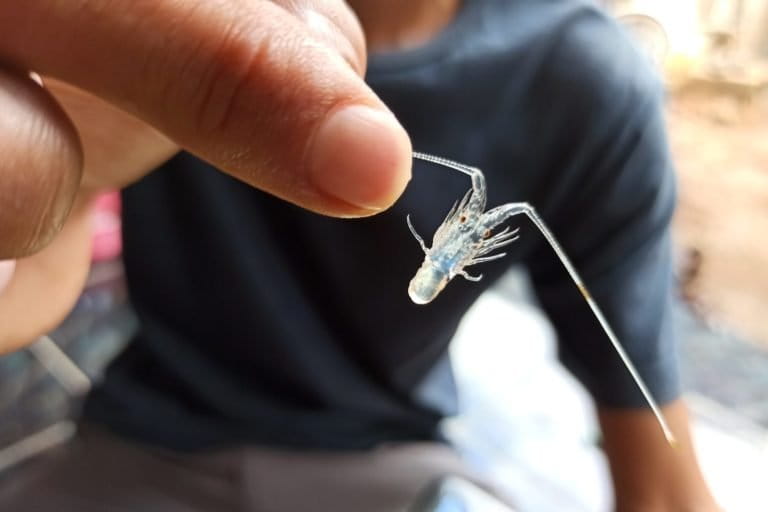- Indonesia is seeking investment from Vietnam to develop Indonesia’s fisheries sector, especially the lobster farming industry, the country’s fisheries minister said during a visit to Hanoi.
- In exchange, Indonesia could supply up to 300 million lobster larvae to Vietnam and would stop seizing Vietnamese fishing boats encroaching into Indonesian waters, instead just turning them back.
- Jakarta banned exports of lobster larvae in 2016 to prevent the overharvesting of wild population from the country’s rich waters, but smuggling remains rampant.
- Despite concerns about potential harm to the domestic aquaculture industry, the government plans to finalize a decree to resume exports, citing the economic benefits and potential to reduce smuggling.
JAKARTA — Indonesia is offering resume direct exports of lobster larvae to Vietnam in exchange for investment in lobster farming and easing up on Vietnamese boats fishing illegally in its waters.
Jakarta banned exports of lobster larvae in 2016 to prevent the overharvesting of wild population from the country’s rich waters. However, Indonesia’s fisheries minister, Sakti Wahyu Trenggono, said on a visit to Hanoi that he would allow exports to Vietnam, which has a much more advanced lobster aquaculture industry.
“I believe that Indonesia in the future is capable of being a key player in the global supply chain of lobster products,” Sakti said in a statement published Jan. 12.

According to Sakti, Indonesian waters are the only breeding grounds for lobsters in the region that can supply wild-caught larvae. However, the country is falling behind in its lobster farming due to adverse government policies and lack of farmer knowledge and skills compared to other countries in Southeast Asia, such as Vietnam. The latter currently produces around 1,600 metric tons of premium-grade lobster a year, with the industry valued at more than $120 million, according to a 2019 study.
Globally, fish farming, or aquaculture, saw a 527% increase in production from 1990-2018, with Indonesia among the top producers worldwide. At the start of his second term in office, in 2019, President Joko Widodo ordered the fisheries ministry to boost the country’s aquaculture productivity.
On a separate occasion, Sakti said Indonesia was seeking investment from Vietnam to develop Indonesia’s fisheries sector, especially the lobster farming industry. In exchange, he said, Indonesia could supply up to 300 million lobster larvae to Vietnam and would stop seizing Vietnamese fishing boats encroaching into Indonesian waters, instead just turning them back.
Vietnam-flagged boats are among the top of the list of vessels caught encroaching into and engaging in illegal, unregulated and unreported (IUU) fishing activity in Indonesian waters. These boats typically deploy single and pair trawl nets, which are known to be indiscriminate and destructive to coral reefs; pair trawling is banned by the Indonesian government. According to experts, the Vietnamese fishers target both commercially valuable fish, competing directly with local fishers, and species that can be ground up for fishmeal to supply the country’s lobster aquaculture industry.

Sakti said the kind of collaboration that Indonesia is seeking with Vietnam would both boost government revenue from lobster aquaculture while also reducing the smuggling of wild-caught lobster larvae. He said these illegal exports remain rampant in part due to poor monitoring efforts.
The fisheries ministry in October 2023 also said it was drafting a decree that could see lobster larvae exports resume under certain conditions. These include exporters partnering with aquaculture farmers and committing to release 2% of their harvest back into the wild. Those same requirements were notably included when Sakti’s predecessor, Edhy Prabowo, lifted the export ban in May 2020. That experiment lasted only briefly, however, ending after Edhy was arrested and jailed for taking bribes to award export licenses.
Sakti said at a Jan. 10 press conference in Jakarta that he expected the decree to be finalized and issued by the end of the month.
“I’ve said to Vietnam as a diplomacy language that if we can partner up then we can be the champions in the region,” Sakti said.
But some fisheries experts remain highly concerned about the resumption of lobster larvae exports, saying it would most likely undermine rather than strengthen the domestic aquaculture industry, and would threaten the sustainability of the species’ wild population. They caution that allowing exports to resume would strongly encourage fishers to catch and sell more larvae as strong demand drives up prices.
The northern coasts of Indonesia’s Java and Lombok islands are the heart of the country’s lobster larvae harvests. In Lombok, sand lobsters make up 90% of the annual catch, according to a study. The lobsters are grown in floating cages and fed small fish until harvested after six months, as they near maturity. In 2012, the industry was valued at $2 million.
A major obstacle to economically viable lobster aquaculture is the high mortality rate during the nursery stage, at more than 50%, which has been widely reported in Vietnam and Indonesia. Lobsters are among Indonesia’s top fisheries commodities, but the illegal export of larvae and baby lobsters cost the country 900 billion rupiah ($64 million) in lost revenue in 2019 alone, according to the PPATK, the national antimoney-laundering watchdog.

Basten Gokkon is a senior staff writer for Indonesia at Mongabay. Find him on 𝕏 @bgokkon.
See related from this reporter:
Indonesia renews effort to resume controversial lobster larvae exports
Citation:
Jones, C. M., Le Anh, T., & Priyambodo, B. (2019). Lobster aquaculture development in Vietnam and Indonesia. In: E. Radhakrishnan, B. Phillips, & G. Achamveetil (Eds.), Lobsters: Biology, Fisheries and Aquaculture. Springer, Singapore. doi:10.1007/978-981-32-9094-5_12
FEEDBACK: Use this form to send a message to the author of this post. If you want to post a public comment, you can do that at the bottom of the page.